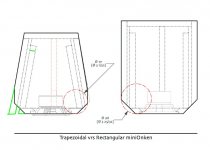round, slanted, wonderful
Dear planet10 and thoglette, thank you for your answers and appologies for slow reactions: we are entering a whole new "exciting" phase of the pandemic here.
Planet10:
Excuse me but perhaps I was unclear in what I wrote. I have no doubt that internally, the usage of trapezoidal sections and angled surfaces is sonically desirable (even if I don't fully understand the radius issue in your comparison). My spouse was not frowning at the trapezoidal cross-section, just at the external, narrow slanted edges that the very vents are on.
However (pardon the naiveté of the question) does the external shape of the cabinet affect the sound at all?
And, if not, how about altering the external shape of the trapezoidal version like in the green changes below? I guess a change in the geometry of the last inch of the "tunnel" will mean it's length needs adjusting at the back end, to stay the same.
Yeah, I know, all of this "just" for looks. Dave, does this make sonic sense at all?
Thoglette:
There must be something good about these round shapes. There is a chinese company called Lii Audio whose flaghship products are evidently inspired by the Coral Beta (8 and 10) drivers. They sell an enclosure for the 10 inch version. It has an "onion" shape cross section, i.e. an ellipse with an extrusion for the bass ports. Perhaps there is a way to adapt the ovoid shape Dave drew?
Needless to say, I am aware this raises production costs. We are either in plywood-bending territory or in quasi-3-d-printing territory here.
Dear planet10 and thoglette, thank you for your answers and appologies for slow reactions: we are entering a whole new "exciting" phase of the pandemic here.
Off Topic:
It's a good thing to speculate about speakers and I am grateful to the whole community for this type of social contact. I do hope to never experience the medical end of this stick, but the simple life implications are already a handful.
As for the cabinets... all plans of project execution have to be on hold. We cannot even buy one screw, walking around stores is a bit irresponsible and the Home-Depot-style hardware suppliers are closed.
So I am stuck in the digital world, but that's also necessary, right?
It's a good thing to speculate about speakers and I am grateful to the whole community for this type of social contact. I do hope to never experience the medical end of this stick, but the simple life implications are already a handful.
As for the cabinets... all plans of project execution have to be on hold. We cannot even buy one screw, walking around stores is a bit irresponsible and the Home-Depot-style hardware suppliers are closed.
So I am stuck in the digital world, but that's also necessary, right?
Planet10:
Excuse me but perhaps I was unclear in what I wrote. I have no doubt that internally, the usage of trapezoidal sections and angled surfaces is sonically desirable (even if I don't fully understand the radius issue in your comparison). My spouse was not frowning at the trapezoidal cross-section, just at the external, narrow slanted edges that the very vents are on.
However (pardon the naiveté of the question) does the external shape of the cabinet affect the sound at all?
And, if not, how about altering the external shape of the trapezoidal version like in the green changes below? I guess a change in the geometry of the last inch of the "tunnel" will mean it's length needs adjusting at the back end, to stay the same.
Yeah, I know, all of this "just" for looks. Dave, does this make sonic sense at all?
Thoglette:
There must be something good about these round shapes. There is a chinese company called Lii Audio whose flaghship products are evidently inspired by the Coral Beta (8 and 10) drivers. They sell an enclosure for the 10 inch version. It has an "onion" shape cross section, i.e. an ellipse with an extrusion for the bass ports. Perhaps there is a way to adapt the ovoid shape Dave drew?
Needless to say, I am aware this raises production costs. We are either in plywood-bending territory or in quasi-3-d-printing territory here.
Attachments
...funny how I seem to understand things late.
Is it that the vents need to be a bit further back than the driver and the ovoid shape is the quide for this retraction?
Is it that the vents need to be a bit further back than the driver and the ovoid shape is the quide for this retraction?
I have no doubt that internally, the usage of trapezoidal sections and angled surfaces is sonically desirable (even if I don't fully understand the radius issue in your comparison). My spouse was not frowning at the trapezoidal cross-section, just at the external, narrow slanted edges that the very vents are on.
Actually the inside of the trapezoid box is not that much of an improvement as the rectangular.
It is the outside. The outside of the box makes a substantial difference in a loudspeaker’s diffraction signature.
At HF we have edge diffraction if the edges are sharp (relative to the frequency). At low frequencies we have baffle step, the change from 2π radiation to 4π radiation. The shape of the box has a decided e=affect on the shape of the ripple.

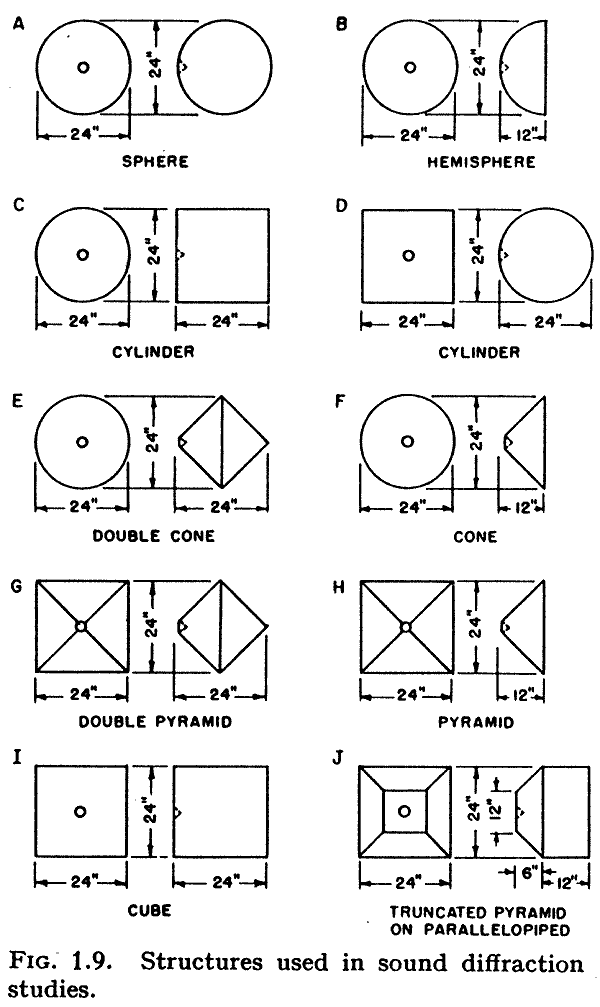
&W has done some of the most extensive work on cabinet shape and ended up with this:
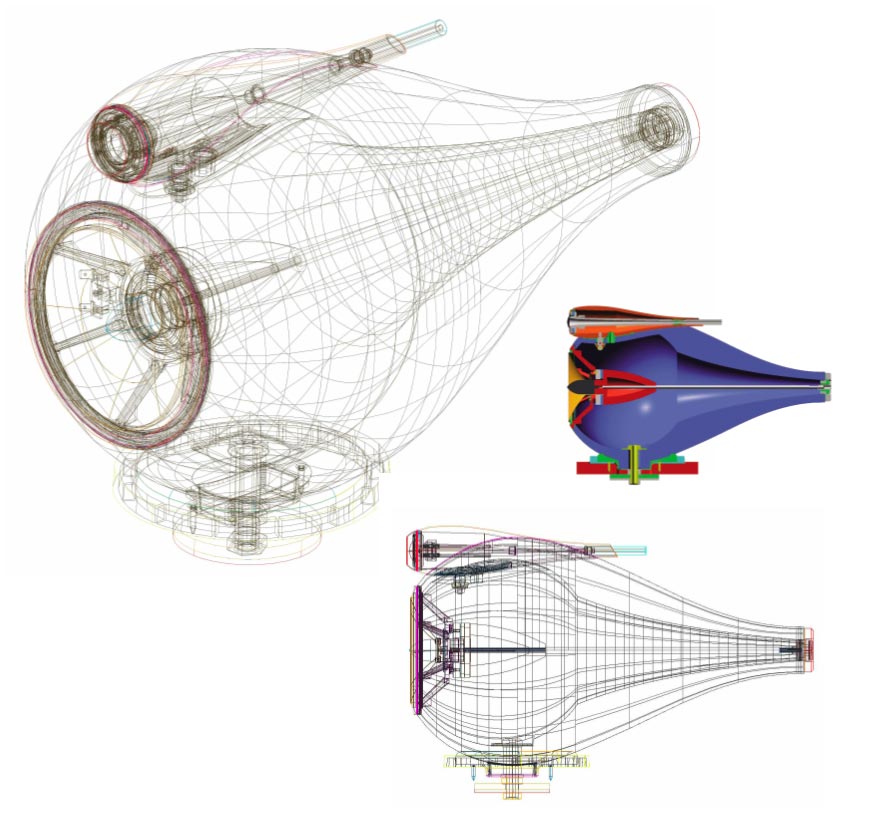
Another example is the Eclipse family
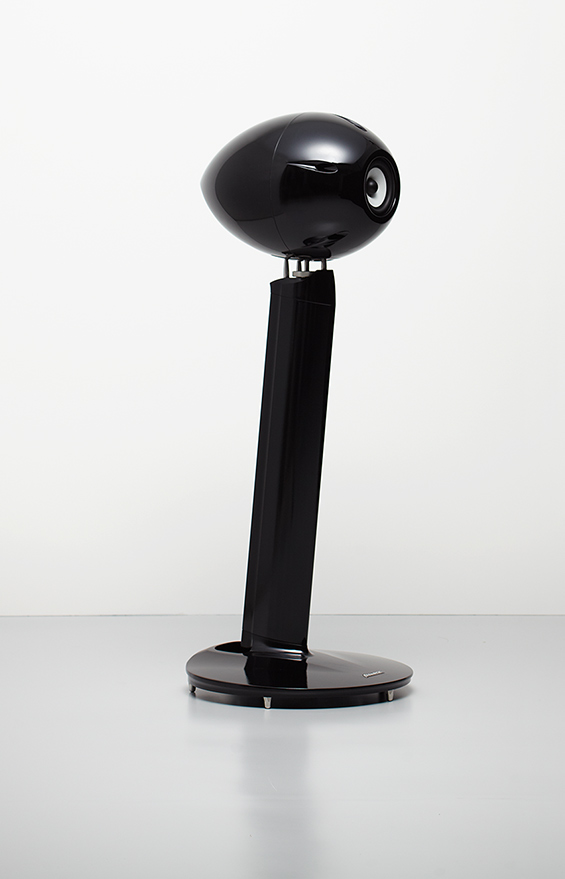
dave
Yes, it's only 1.25" on the one side (but the router bit was a special order) so limited to mids & highs but it's quite audible if one swaps the L & R (or even gets the toe-in wrong)Don’t know what you are trying to point out with Lynn’s words, but for a chamfer/roundover to be effective into the lower frequencies, it needs to be fairly large.
I have several box shaped speakers as well (my other half doesn't understand why one set isn't enough 😀 ) and they are universally more "boxy". The radiused edges are only one of a set of tricks Lynn used to minimise this.
The other one I'll definitely include in my Axikens is something to deflect the back-wave from the driver - so as to stop it hitting the back of the cone a millisecond (or thereabouts) later. Quite what I've not decided. Possibly some more (angled) stiffeners - can't have too many of them.
wow
Dave, you opened my eyes to a whole new topic (by pointing to the external shape of the cabinet). Would this not mean that all the objects in the appartment participate in the same diffraction game? Or is this reserved for those that are close to the emmission source (=driver)?
Also interesting is the table you linked. Of course, I understand that the depicted curves are not exact dot-for-dot frequency-responses of real cabinets that would have those particular shapes, but still.
A possible DIY path to more fluid (less boxy) shapes is translamination. Labour-intensive and material-hungry, that's what I meant by quasi-3-d-printing above. There are many implementations, including this diy one, and even kits.
non-audio factors:
My problem with rounded shapes is an aesthetical one.
Namely, it's hard to make a shape that does not stand out and – if it does stand out – that does not look bad.
The object (loudspeaker) then becomes more visible in the appartment, something of a "sculpture". I really don't want modernist public sculpture in front of my couch, especially if looks were a secondary factor and sound signature was the main shaping criterion. There is a dark dumpster somewhere in my heart, where I toss pyramidal speakers or (worse) stacks of ever diminishing boxes with smaller and smaller tweeters, diamond-shaped slanted, multi-faceted alien spaceships, conical or trumpet-wielding marvels. Yes, this is personal. 🙂
The Eclipse and the B&H you linked are a lot more minimal then what I described above and the both look great. Probably if we want to energize a room these can't be too small though. And then we land in sculptural territory again.
Dave, you opened my eyes to a whole new topic (by pointing to the external shape of the cabinet). Would this not mean that all the objects in the appartment participate in the same diffraction game? Or is this reserved for those that are close to the emmission source (=driver)?
Also interesting is the table you linked. Of course, I understand that the depicted curves are not exact dot-for-dot frequency-responses of real cabinets that would have those particular shapes, but still.
A possible DIY path to more fluid (less boxy) shapes is translamination. Labour-intensive and material-hungry, that's what I meant by quasi-3-d-printing above. There are many implementations, including this diy one, and even kits.
non-audio factors:
My problem with rounded shapes is an aesthetical one.
Namely, it's hard to make a shape that does not stand out and – if it does stand out – that does not look bad.
The object (loudspeaker) then becomes more visible in the appartment, something of a "sculpture". I really don't want modernist public sculpture in front of my couch, especially if looks were a secondary factor and sound signature was the main shaping criterion. There is a dark dumpster somewhere in my heart, where I toss pyramidal speakers or (worse) stacks of ever diminishing boxes with smaller and smaller tweeters, diamond-shaped slanted, multi-faceted alien spaceships, conical or trumpet-wielding marvels. Yes, this is personal. 🙂
The Eclipse and the B&H you linked are a lot more minimal then what I described above and the both look great. Probably if we want to energize a room these can't be too small though. And then we land in sculptural territory again.
And again, a belated epiphany: sound is a form of radiation. Therefore, its intensity decreases with the square of the distance. It would make sense that any influence of a shape also is subject to that proportion. Which means that rounding (angling, chamfering, etc) has an effect mainly when it concerns surfaces close to the radiation source (drivers, passive membranes, ports and so on). Did I get it? 🙂
Would this not mean that all the objects in the appartment participate in the same diffraction game?
Yes. The closer the objectthe sooner the effect. If it is close enuff to be within the ear/brain’s tie window, it gets folded into what we percieve as the direct sound and “blurs” it.
shapes is translamination
Weird shapes is the only real asset of a translnm box. But otherwise it is a crappy approach.
I expect that it will become a thing of the past when 3D printers become cheaper, larger, better, and more common, translam will become a thing of the past. Adding just the material you need instead of taking a big block and throwing the parts you don’t want away.
Probably if we want to energize a room these can't be too small though. And then we land in sculptural territory again.
The size does usually need to be scaled with frequency.
dave
My problem with rounded shapes is an aesthetical one.
Hw about this shape:
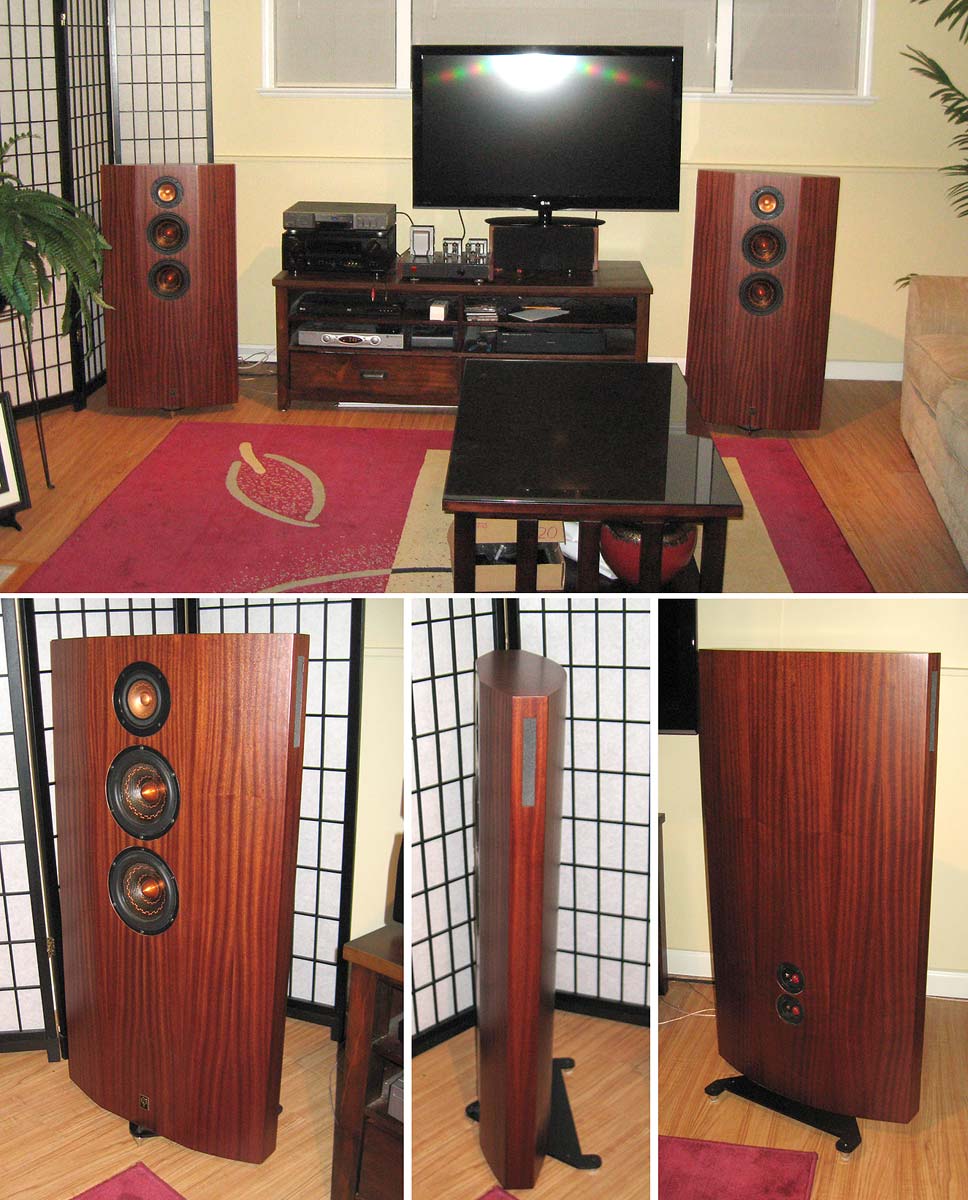
It pushes edge issues way away in time, the baffle slowly falls away further decreasing things, and the wide stance, pushed aprpropriately close to the wall has an effective transition from 2P to 4P such that the wall takes over and effective radiation remains 2π.
dave
rokikiki, few things one can do with loudspeaker lools: hide them into a wall or as part of furniture. Camouflage is another trick, paint in the same color as the wall behind.
Looks and audio quality are kind of trade-off, but loudspeakers are full of trade-offs so it is just matter of choosing to optimize the looks and be happy with the audio quality.
I think the biggest advantage of DIY audio is to optimize the looks and I want speakers to disappear 🙂
Looks and audio quality are kind of trade-off, but loudspeakers are full of trade-offs so it is just matter of choosing to optimize the looks and be happy with the audio quality.
I think the biggest advantage of DIY audio is to optimize the looks and I want speakers to disappear 🙂
Hi tmuikku, hiding in the walls is a good idea, others have pushed the envelope in this matter. For me it's too late, my walls are like Saddam's bunker (I live in Poland, we are crazy about house solidity here).
Dave, those look great! Wow. Are they designed by you?
I try to imagine them with a single 12 inch driver and they might be just wonderful! I think I also get the principle of pushing the edge as far from the sound source as possible while softening the relief (and curvature) surfaces.
As for translamination: I was just mentioning it as an alternative idea. In fact, photos like this one show you how wasteful this process is. Not only because I have to exist on a teacher sallary but also respect for our planet kind of elminates this solution. One would have to waste sheet after sheet of MDF or plywood to use this solution.
I think I remember an Australian speaker review on six moons where they described a curved surface as being a laminate of jaccaranda wood with a lead insert for sonic neutrality. Perhaps this would be a killer option for such delicately curved walls. I mean the lead sheet insert, not the finish.
Dave, those look great! Wow. Are they designed by you?
I try to imagine them with a single 12 inch driver and they might be just wonderful! I think I also get the principle of pushing the edge as far from the sound source as possible while softening the relief (and curvature) surfaces.
As for translamination: I was just mentioning it as an alternative idea. In fact, photos like this one show you how wasteful this process is. Not only because I have to exist on a teacher sallary but also respect for our planet kind of elminates this solution. One would have to waste sheet after sheet of MDF or plywood to use this solution.
I think I remember an Australian speaker review on six moons where they described a curved surface as being a laminate of jaccaranda wood with a lead insert for sonic neutrality. Perhaps this would be a killer option for such delicately curved walls. I mean the lead sheet insert, not the finish.
PS: here it is: 6moons audio reviews: WHT PR1
Various materials in multiple layers are used to line the internal walls including lead lining, bitumen and a special lamb's wool cloth.
Dave, those look great! Wow. Are they designed by you?
I try to imagine them with a single 12 inch driver and they might be just wonderful!
Yes, i designed it (as a stretched polygonal prism) Chria decided that real curved panels would be better and it would give him a chance to play with vacuum bag work.
The concept of the design could easily be modified to hold a 12” helper woofer. The box volume in these for the 2xSDX7 is quite small, something like 35 litres, making the box deeper would quickly increase the volume.
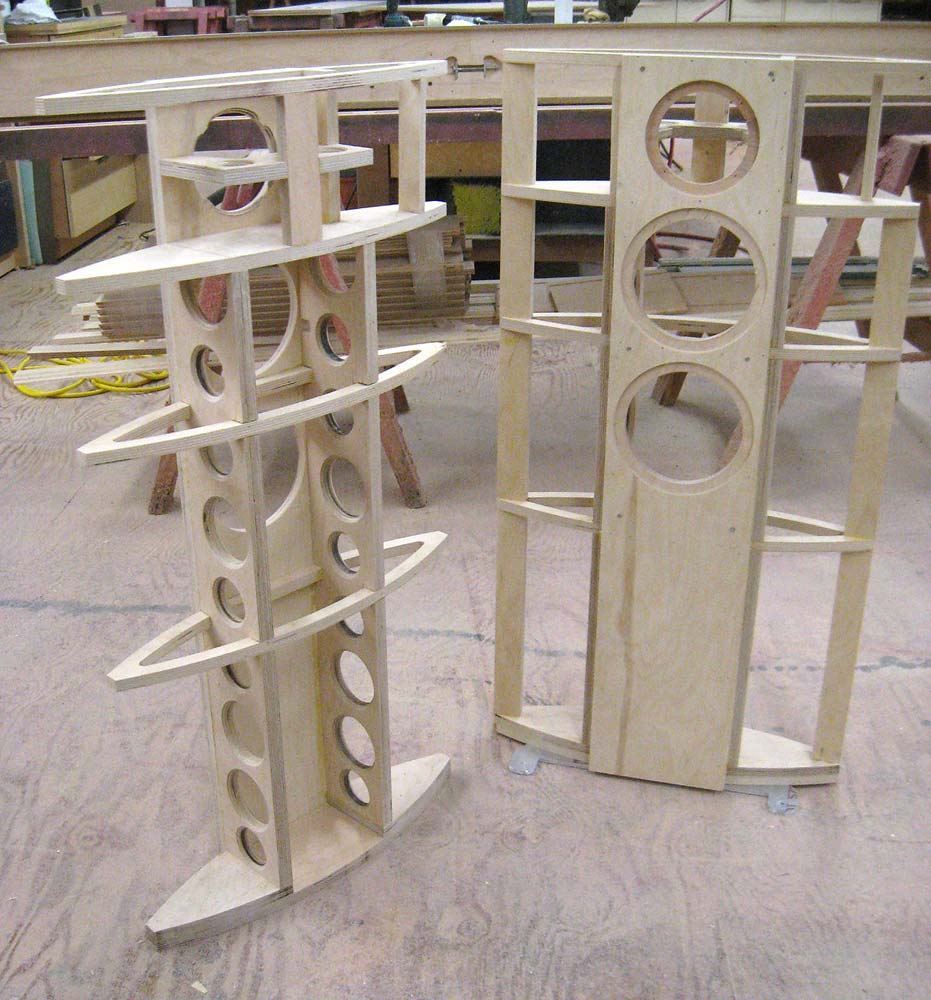
The top slice is the midTL for the midTweeter, the volume below is sealed for these woofers.
The curved panels from these were also used to make a set of Pensi7 with curved sides.
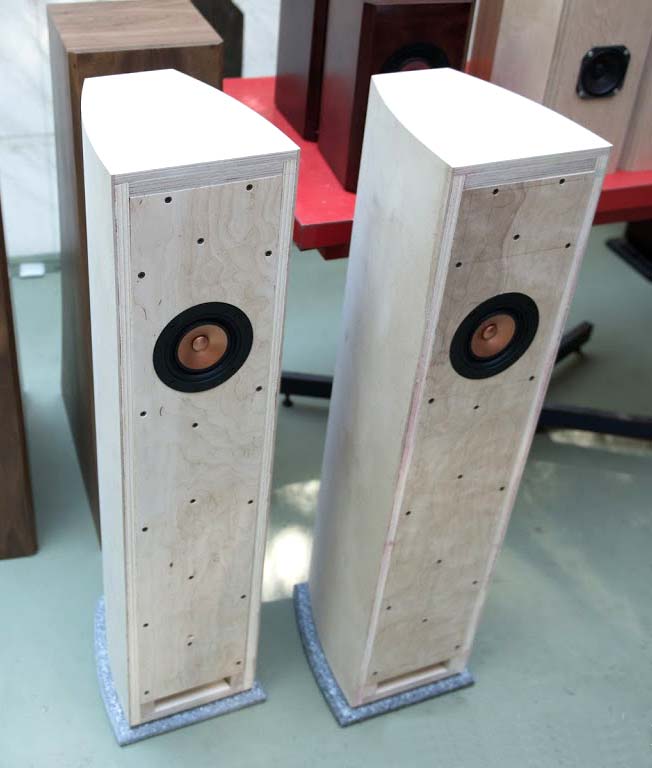
dave
wow, this looks really nice, do you think it will work as a full-range single driver system (i.e. without a xover?)
WHT PR1
I don’t know about the driver, but the horn is not impressive.
dave
wow, this looks really nice, do you think it will work as a full-range single driver system (i.e. without a xover?)
Sure, shapes can be adapted.
dave
Well, the WHT was a wet dream of mine back in the time when I didn't know how to read between audiophool mumbojumbo lines. The funniest thing about that speaker is slapping a patch of black stocking on a stock fountek tweeter and calling it "customisation".
But back to *reality* - your project looks very interesting - I understand is it a sealed box in that configuration, but would it be a sealed box for a 12inch axiom 201 as well? Or would it need vents/bass reflex in some form?
But back to *reality* - your project looks very interesting - I understand is it a sealed box in that configuration, but would it be a sealed box for a 12inch axiom 201 as well? Or would it need vents/bass reflex in some form?
Last edited:
- Home
- Loudspeakers
- Full Range
- Cabinets for Full Range Goodmans Axiom 201
